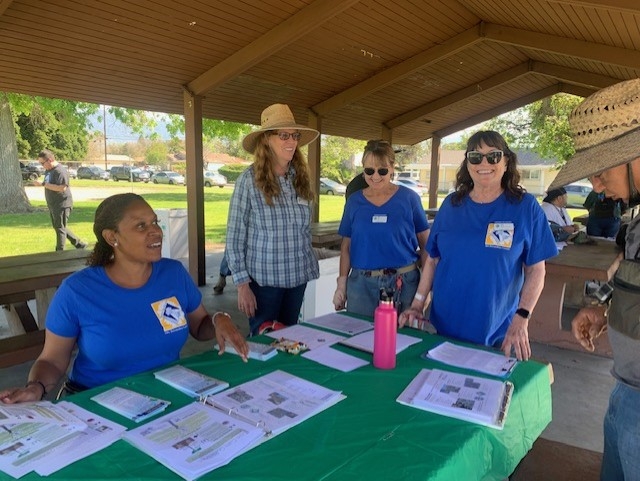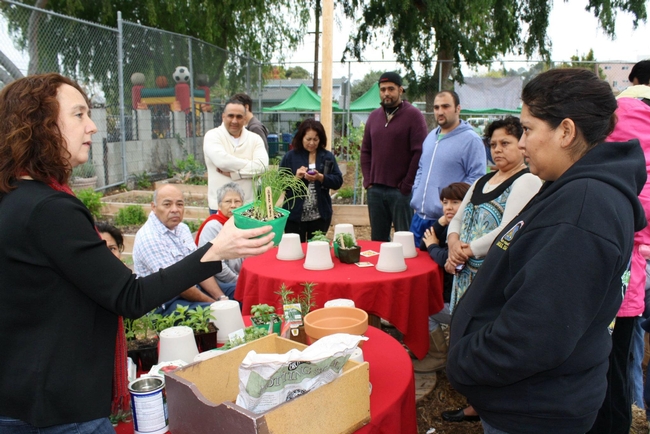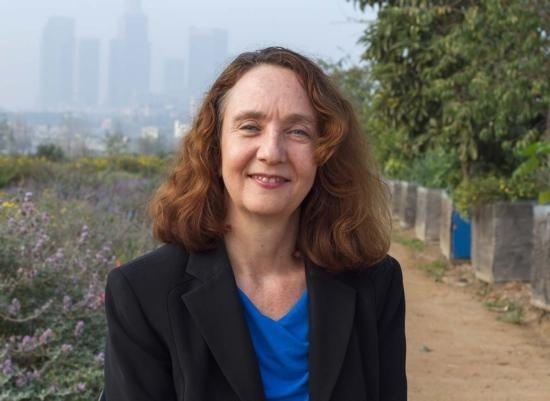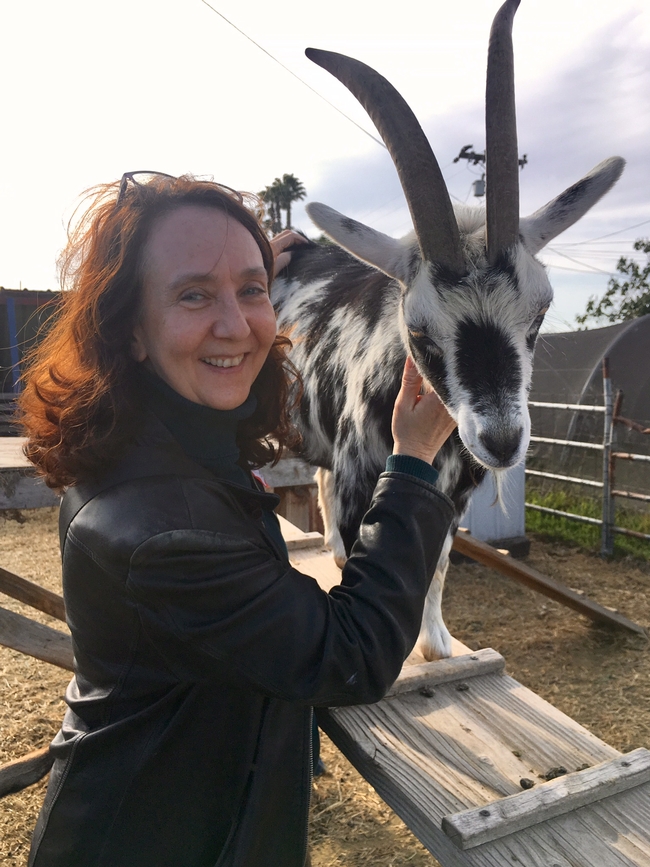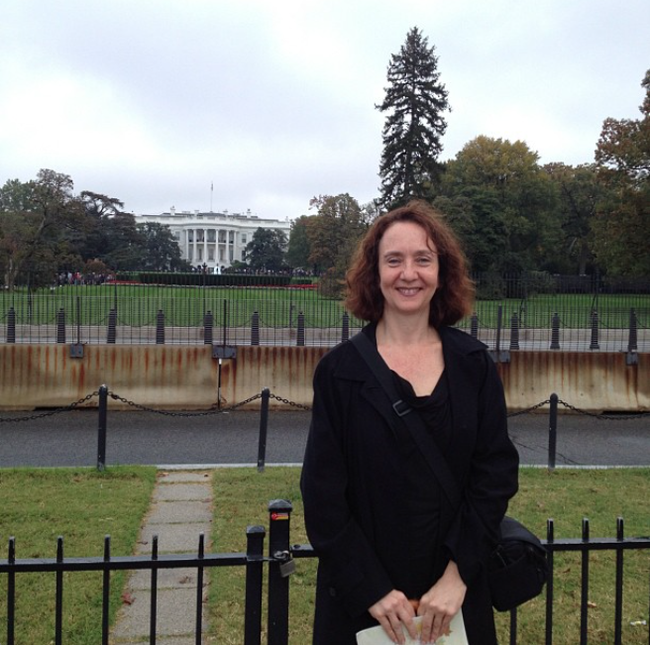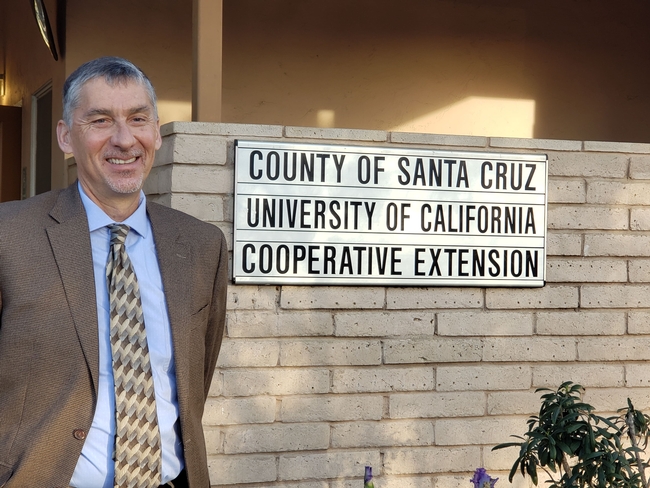
Posts Tagged: Cooperative Extension
2,000 Climate-Ready Trees Provided to Residents of Low Shade Neighborhoods
To date, over 2,000 climate-ready shade trees and tips on their planting and long-term care have been provided by UC Master Gardeners and over 20 partners to residents of low shade neighborhoods in San Bernardino and Riverside Counties through the “Trees for Tomorrow Start Today” project. Tree species given away are identified from research projects including the joint University of California/United States Forest Service (USFS) study at UC Riverside as well as from other research, local observations, and input from the green industry and academic colleagues.
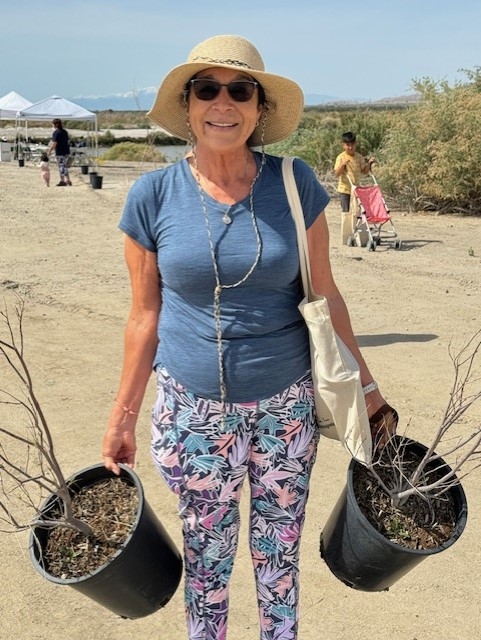
Why is this project so important? 95% of Californians now reside in cities and suburban environments. Resulting urban heat islands created by built environments coupled with impacts of climate change can be mitigated through nature-based solutions. Planting climate-ready shade trees now will help ensure cooler urban areas in the next several decades as trees mature and maximize their urban ecosystem benefits. Fortunately, the shade from a single well-placed tree can decrease surface temperatures of black asphalt and artificial turf by more than 70 degrees F in hot inland and desert cities. Studies show that surrounding air temperatures can also be reduced through the transpiration process.
A major goal of the"Trees for Tomorrow Start Today" project is to enhance tree canopy cover in low shade neighborhoods also plagued with much higher than average levels of air pollution and pulmonary and cardiovascular disease incidence. Events over the past month have occurred in Fontana, San Bernardino, and the Salton Sea.
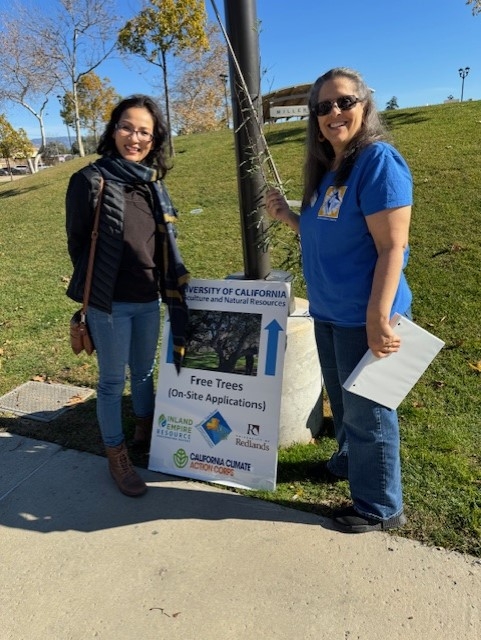
Thank you to all our partners and, especially, our tree recipients, for greening and cooling your yard and neighborhood! 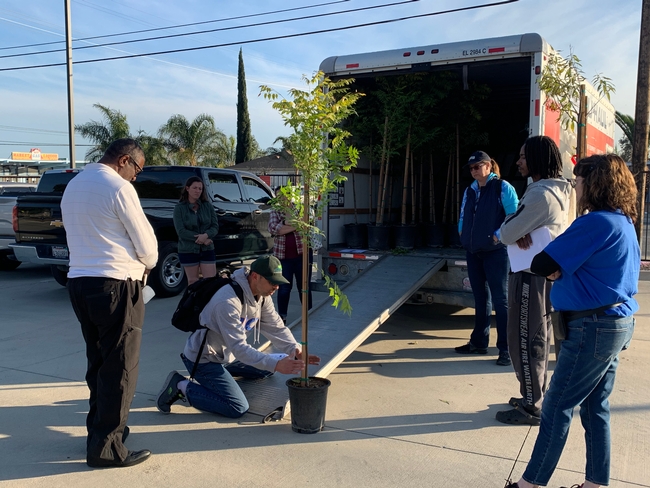
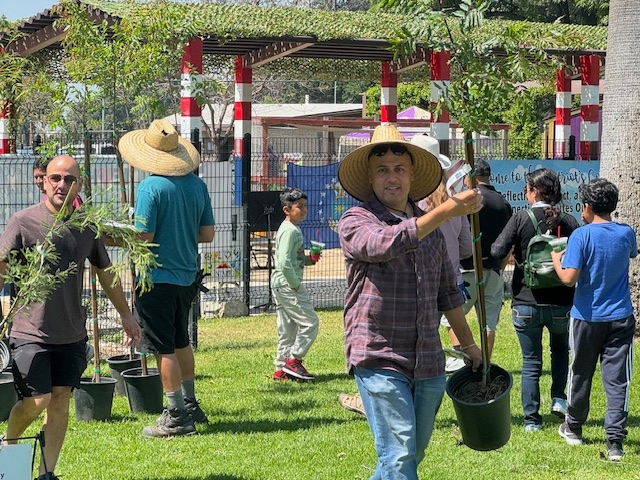
Rachel Surls has cultivated a healthier LA County through gardens
UC Cooperative Extension advisor who promotes school gardens, urban agriculture to retire after 35-year career
A stroll through a leafy, green garden can give one temporary relief from life's harshness. During her career, Rachel Surls has used gardens to cultivate healthier communities, whether they are growing nutritious food or providing science lessons for students.
Over the past 35 years, Surls, University of California Cooperative Extension sustainable food systems advisor in Los Angeles County, has witnessed many changes – such as promoting public events on Instagram rather than typing and mailing press releases. A comforting and consistent presence has been the UC Master Gardener Program, part of UC Agriculture and Natural Resources.
“As I look back, the UC Master Gardener Program has been a constant in my work. It helps so many people,” said Surls, who joined UCCE as a school and community garden coordinator in 1988.
“My new job with UCCE-LA was my dream job. I organized community gardens around the county and supported teachers who wanted to start school gardens,” recalled the Michigan native, who plans to retire at the end of the year. “I had a bachelor's degree in agronomy and was freshly out of a stint with the U.S. Peace Corps in rural Honduras. My work there inspired me to pursue community development work related to gardening.”
Louisa R. Cardenas, trustee of Los Angeles County Natural History Museums, was a UC Master Gardener volunteer for 25 years.
“Among Rachel's many skills and assets are her willingness to listen to and consider ideas from Master Gardeners that eventually reach and empower Los Angeles County residents to grow food that supplements their nutritional needs,” Cardenas said.
To complement the nascent UC Master Gardener Program in Los Angeles County, Surls organized “Gardening Angels,” a cadre of volunteers to work with teachers and students to develop school gardens. She edited a guide for teachers, parents and volunteers to build gardens for children.
“I met Rachel in 1992 and was so blessed to come up through the ranks with her,” said Rose Hayden-Smith, UCCE emeritus advisor in digital communications in food systems and extension education. “We were in neighboring counties, and had many similar programmatic interests, including school gardens. Her research informed my work and was so helpful to me.”
Advancing food security, community nutrition
In 1994, after earning her master's degree from Cal Poly Pomona in agricultural science with a focus on agricultural education, Surls accepted a newly created position: UC Cooperative Extension urban horticulture advisor.
To retain Los Angeles County funding in 1992, the UCCE staff had become part of the county's Housing Authority/Community Development Commission. As the UCCE urban horticulture advisor, Surls was tasked with developing gardens at five public housing sites. At one of these locations, Carmelitos Housing Development in Long Beach, she worked with community partners to select landscape trees, hire a greenhouse contractor and design a horticulture job training program for public housing residents. This site became known as the Growing Experience Urban Farm.
“I'm pleased that 29 years later, the Growing Experience is still an active community farm where UC Master Gardeners offer workshops for the community,” Surls said.
In 1997, when George Rendell retired as director of UCCE in Los Angeles County, Surls applied for the job. For the next 14 years, she oversaw more than 70 employees and local programs, including the 4-H youth development program, which launched afterschool, hands-on learning for children.
Surls, who participated in 4-H herself as a child, worked closely with 4-H funders. She helped secure grants, contracts and gifts for 4-H as well as the UC Master Gardener Program and UCCE nutrition programs for projects that encouraged Angelenos to eat more fruits and vegetables.
“Rachel was incredibly creative and innovative as a leader,” said Hayden-Smith, who served as director of UCCE in Ventura County. “Rachel models a kind of quiet leadership that invites people into the process, honors the group and moves work forward in important ways.”
While working, Surls earned her Ph.D. in higher education administration at Claremont Graduate University in 2008, with an eye on pursuing other leadership roles. Instead, the global financial crisis inspired her return to working directly with Los Angeles County residents on urban gardening to reduce food insecurity.
To focus on outreach, the UCCE sustainable food systems advisor handed her UCCE director duties to Keith Nathaniel, UCCE 4-H advisor, at the end of 2011.
Developing, sharing resources for urban farming and gardens
In 2012, she organized colleagues within UC Agriculture and Natural Resources and community partners to study the needs of urban farmers and begin offering workshops for them. She led the development of an urban agriculture website, with resources covering business management, food safety, marketing and regulations. She served on the leadership board of the Los Angeles Food Policy Council and began advising cities on policies that would make it easier for residents to grow food.
“These have been my favorite and most productive years of my career,” Surls said.
Drawing on skills she began honing as an undergraduate at Virginia Tech as a news writer for the Virginia Extension Service, Surls co-authored a book about the history of agriculture in Los Angeles County, called “From Cows to Concrete: The Rise and Fall of Farming in Los Angeles.” She is currently working on a second book about urban farming in the U.S.
The Grow LA Gardens Initiative – which helps aspiring gardeners start their own gardens quickly – is one source of pride for Surls. Hundreds of people have taken the four-week course and, after participating, nearly 70% planted gardens.
In 2018, Surls was honored with the Bradford-Rominger award by the Agricultural Sustainability Institute at UC Davis for her work promoting community gardens, school gardens and urban agriculture.
With community gardens and school gardens now commonplace, Surls chuckles as she recalls veteran UCCE colleagues advising her to choose a more “serious” academic focus early in her career.
“It's gratifying to see so many people in academia working on farming in cities, school gardens and community gardens,” Surls said.
Advocating for equity
In 2022, while Surls was on sabbatical, she and Cardenas – the longtime UC Master Gardener volunteer – requested and received $100,000 from the Los Angeles County Board of Supervisors to hire an equity, diversity and inclusion coordinator and to fund outreach. This UC Master Gardener project championed by Supervisor Sheila Kuehl specifically reaches underserved populations within the county. “Such a significant achievement would not have been possible without Rachel's encouragement and support,” Cardenas said.
After she retires, Surls plans to volunteer her expertise for online training of UC Master Gardener volunteers statewide. To support their program efforts including outreach to the Spanish-speaking community and scholarships for underserved communities, Surls has pledged to give $5,000 as a matching gift to donations to the UC Master Gardener Program in Los Angeles between Giving Tuesday, Nov. 28, and Dec. 31 at https://ucanr.edu/LAmastergardener.
Fall Colors Explained
Welcome to Fall!
It's my favorite season and likely for many of you, as well. Beyond the holidays and extra time with family and friends, nature radiates its beautiful hues. In addition to lovely foliage, deciduous trees often expose exquisitely shaped and sturdy trunks. And, of course, there is the lovely fall foliage showcased by many species.
Did you ever wonder why trees "turn" color in the fall? The short answer: It's primarily a function of long, cool fall nights and short, sunny days. The longer answer? Chlorophyll is responsible for the basic green color of leaves we see in spring and summer and is a necessary component of photosynthesis, which uses sunlight to manufacture sugar (food) that is stored during the dormant period of the year. Carotenoids produce yellow, orange and even brown pigments in crops such as carrots, squash, bananas and many ornamental plants such as daffodils and poppies. Anthocyanins are red and orange in color and are most linked to lavish displays of brilliant fall foliage. They also give rise to coloring of strawberries, plums and cherries.
Here's the kicker: While chlorophyll and carotenoids are present in leaf cell chloroplasts throughout the entire growing season, during fall chlorophyll begins to break down. Voila! The lovely yellow and orange hues we all look forward to seeing are finally exposed. In addition, red hues (called anthocyanins) are produced in fall. So, in reality foliage doesn't "turn" orange or red at all.
Interestingly, the actual timing of color change varies across species and appears to be genetically inherited. The same species will exhibit a similar color scheme in cool temperatures in higher elevations at nearly the same time as it does in warmer lower elevation climates.
The intensity of color can vary quite a bit however. Where do temperatures enter the picture? Both the amount of color and the overall intensity of fall color is very linked to weather conditions that occur prior to and during the actual time the chlorophyll in leaves winds down. The most brilliant displays occur after several warm, sunny days and cool, crisp (above freezing) nights. This is because although lots of sugars are made in leaves during sunny daytime hours, the corresponding cool nights prevent the sugars from moving out. The amount of soil moisture also helps ensure that from year to year fall colors vary even in the same trees. So, either a late spring or a prolonged drought can both delay the display of fall color by a few days or even a few weeks.
What's the recipe for the most brilliant fall display? Most likely a warm, moist spring followed by a warm summer and sunny fall with cool autumn nights. Although fall color is not nearly as spectacular in lower elevations of Southern California compared to other colder areas of the nation, the liquidambar or American sweet gum (Liquidambar styraciflua) offers some pretty impressive fall color and an impressive 300 to 400-year life span. (Did you know that liquidambar got its name because it at one time was a sought-after chewing gum for Native Americans?)
Two “climate-ready” tree species with lovely fall foliage that grow in both the west portion of the county and the desert are the ‘Keith Davey' Pistache, a large street and park tree sporting crimson to scarlet colored foliage and its relative, the ‘Red Push' Pistache, a hybrid between P. atlántica x P. integerrima) which has lovely red foliage as it emerges in Spring as well as Fall. Others include the Raywood Ash (Fraxinus oxycarpa 'Raywood') sporting a reddish-purple hue in the fall, and the ‘Sunburst' Locust (Gleditsia triacanthos var. inermis 'Sunburst') which offers a vivid display of fall color. Unfortunately, it is susceptible to the Invasive Shot-Hole Borer. If you have one of these lovely trees already, take good care of it to help it stand up to this aggressive pest!
Happy Fall! Enjoy the cooler weather, family and friends, and lovely trees!
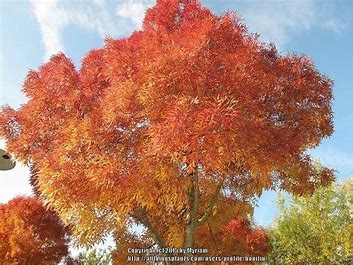
Raywood Ash source national gardening association
Valliere brings expertise in restoration ecology
It all started with pumpkin seeds Justin Valliere has been hired to expand the Department of Plant...
Gonzalves begins as new UC Cooperative Extension director for Monterey, Santa Cruz and San Benito counties
David Gonzalves started on Feb. 1 as director for University of California Cooperative Extension in Monterey, San Benito and Santa Cruz counties. UC Cooperative Extension connects communities across California with UC research and science-based solutions through agriculture, natural resources, nutrition and 4-H youth development programs.
Responsible for the overall operation of UCCE educational and applied research programs in the region, Gonzalves also will build and expand partnerships with county and city governments, public agencies and community organizations.
“David brings tremendous expertise in administration, fostering strong relationships, and building effective teams,” said Deanne Meyer, interim associate vice president for programs and strategic initiatives at UC Agriculture and Natural Resources, which administers UCCE statewide. “His track record of engaging local agencies, business partners, stakeholders and community groups will be invaluable as we explore new collaborations to reach and serve more Californians.”
Gonzalves was most recently a campus building official at UC Merced. Beginning his career at the County of Merced as a fire inspector, Gonzalves worked his way up to supervising building inspector and eventually assistant development services director. Then, for the City of Merced, he filled the role of chief building official and ultimately director of development services, leading the city's Building, Planning and Engineering teams. For three years, Gonzalves served as Tuolumne County's Community Resources Agency director.
“David's past experience as an administrator in county government and at UC Merced makes him the ideal candidate for the work we do at UCCE, as he has demonstrated success in being able to successfully negotiate these two worlds,” said Lynn Schmitt-McQuitty, interim director for county Cooperative Extension at UC ANR.
Gonzalves said he looks forward to meeting with county leaders, members of local boards, growers, UC Master Gardener volunteers, 4-H members and community members to learn how UC Cooperative Extension can help meet local needs.
“My big picture goal is to allow UCCE advisors, administrative teams and local county leaders to have a coordinated approach to our local challenges and successes,” Gonzalves said. “Our efforts will concentrate on freeing up our research teams' calendars to ensure they can continue producing cutting-edge accomplishments here in the tri-county area.”
Based at the UCCE Monterey County office in Salinas, Gonzalves can be reached at dgonzalves@ucanr.edu or (831) 392-5916.

